Top 10 most consistent ASX ETFs for growth and income
What is consistency? That’s easy, it’s doing the same thing with little variation over time, it’s knowing what to expect.
Consistency is highly valued in investing. An investment with a consistent outcome allows us to plan ahead and understand if we might meet our investing goals – both in the short term and well into retirement.
But as far as many investments go, there’s consistent and there’s high return. The two don’t always match up. As investors, we must consider whether chasing a higher return will come at the cost of the consistency in that return. Perhaps there’s a stock you own which doesn’t produce the absolute best performance, but the performance it does produce is very consistent and that’s good enough for you.
This article aims to answer the question of how one can objectively measure return against consistency, and in doing so, it aims to find the most consistent ASX ETFs for growth and income. To do this, we’ll consider each ETF’s performance against its consistency – just like professional fund managers do.
Volatility is the opposite of consistency. In financial markets, the volatility in an asset’s returns has long been used as a proxy for its risk – and professional investors understand that consideration of an asset’s return without consideration of its risk is irrelevant.
In each category below, I have considered each ETF’s performance on a 5-year basis as I feel this is sufficiently long enough to give investors a good idea how it has performed across a range of market conditions, but also not too long to eliminate from consideration newer funds (keep in mind ETFs are a relatively new phenomenon on the ASX). Let’s dive in!
This article uses monthly volatility data, and therefore was written based upon fund performances as at 31 March 2025. This means the results below do not account for subsequent market volatility, including the recent selloff. The concepts remain robust, however, and even more relevant: How does an investor weight return and risk when selecting selecting an investment?
THE MOST CONSISTENT ASX GROWTH ETFs
Top 10 ASX Equities (Ex-Income, Dividend, & High Yield) ETFs
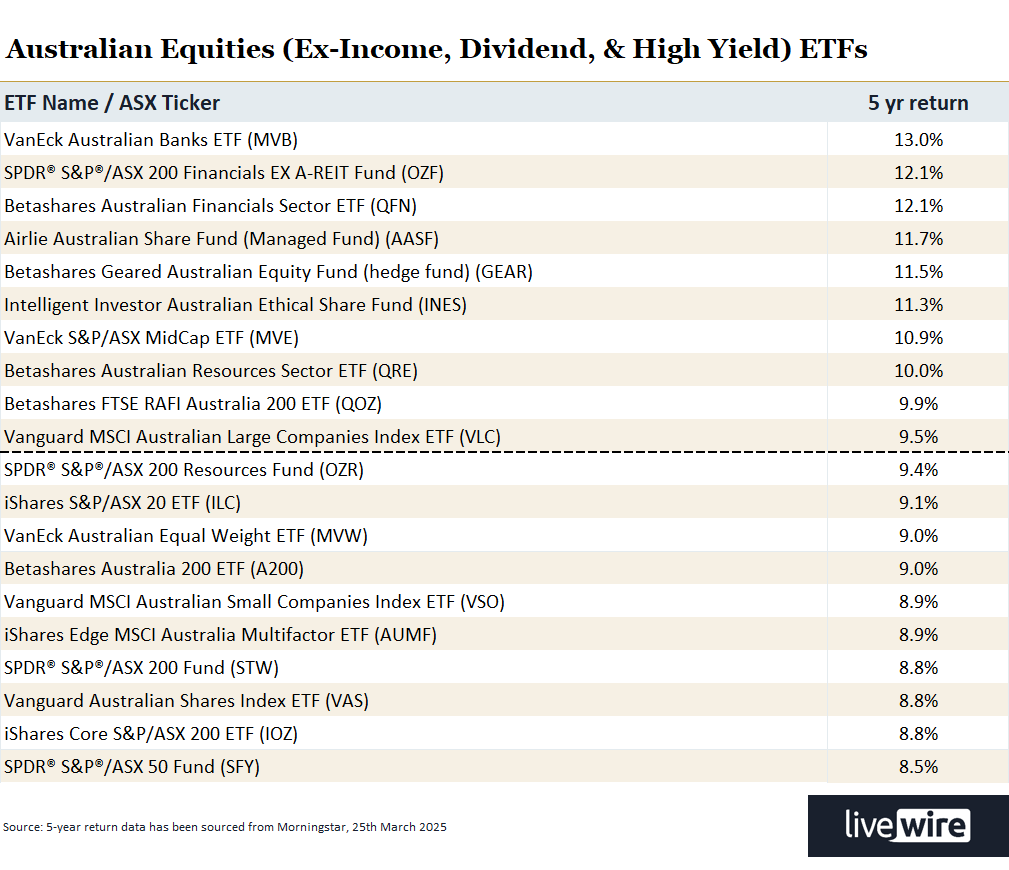%20ETFs.png)
The Top 10 Australian Equity ETFs (ex-Income, Dividend, & High Yield) over the last 5-years - the “Return Only” list.
The table above shows the 20 best performing ASX Australian equities ETFs over the last five years excluding ETFs focussed on income and/or dividends and/or high yield. I’ll refer to these as “Growth” ETFs. We’ll look at those excluded here in the “Income” category below. All performance data is taken from Morningstar via our Find Funds page, and all dividend data is taken from Norgate Data.
2024 was in many ways the year of the banks – ANZ, CBA, NAB, and WBC each saw their share prices soar – much to the dismay (and in often disdain!) of many value-based fund managers and research analysts at the big brokers. Love them or hate them, last year’s “standard deviations from the mean” performance helped the VanEck Australian Banks ETF (ASX: MVB) to first place on the Australian Equities Growth ETFs leaderboard – but I suggest it also had plenty to do with SPDR® S&P®/ASX 200 Financials EX A-REIT Fund (ASX: OZF) and Betashares Australian Financials Sector ETF (ASX: QFN) making second and third places respectively.
Commendable performances are delivered by the rest of the top 10, with all but two delivering double digit compound annual returns greater than 10% over the last 5 years. Note, I have included the next 10 best performing ETFs to round out a broader list for your reference, and as these will become more important in our next step.
There’s your Top 10 Australian Equities Growth ETFs. But that’s kind of irrelevant given the title of this article has the words “Most Consistent” in it.
As I said in the introduction: Reward without risk is irrelevant. If I told you I have an investment where you’ll make $1 million after 12 months, you might think it sounds pretty good. But what if I told you there’s an 80% chance you could lose $1 million in the process. Still interested?
Earlier, we defined consistency as “without much variation over time”. The concept of lack of variation is also extremely important when assessing the return on an investment, as volatility in an asset’s returns is considered a proxy for its risk. This is why financial analysts often use the standard deviation in an asset’s returns over a specified period to represent its riskiness.
If we want to objectively identify the most consistent ETFs, then we must consider both return and risk. This means calculating each ETF’s risk-adjusted return. The Sharpe Ratio is one of the most commonly used methods to measure the risk-adjusted return of an asset. It measures the excess return (i.e., above a risk-free rate) the asset produces per unit of risk.
The risk-free rate represents a benchmark hurdle rate of return, and it makes sense to use it if we consider that as investors we should assess the value we add on top of the “do nothing” option of investing in risk-free cash.
If we look at the formula for the Sharpe Ratio, we can see that excess return is defined as the security’s return minus the risk-free rate (Rx – Rf), which is then divided by the volatility of the security’s return. The standard deviation of the security’s return is used to measure its volatility (StdDev Rx).
Sharpe Ratio = (Rx – Rf) / StdDev Rx
Consider two securities, A and B, that have the same excess return. Security A’s return occurred with lower volatility than Security B’s return. This means Security A will have a higher Sharpe ratio than Security B. In summary, for a specific return, securities that have a lower volatility will have a higher Sharpe Ratio. In this way, a higher Sharpe Ratio is associated with a higher risk-adjusted return.
We could now calculate the Sharpe ratio for each of the top 20 Australian growth ETFs shown above, but I have one main problem with the Sharpe ratio – it ascribes equal weight to an asset’s upside and downside volatility. So, a stock that delivered bouts of massive gains during the lookback period will naturally have a higher StdDev Rx, and therefore a lower Sharpe Ratio.
This is unfair. The Sharpe Ratio punishes what I call “beneficial volatility”. This is why I prefer to use the Sortino Ratio, which focusses only on downside volatility, or as I call it, “adverse volatility”. More specifically, the Sortino Ratio focusses on downside volatility below a selected benchmark.
This is again referred to as excess return, but the benchmark doesn’t have to be the risk-free rate. The Minimum Acceptable Rate (“MAR”) is a subjective measure of the minimum rate that an asset’s return should be compared to. For example, as we are measuring growth-style assets, we should be compensated for at least risk-free rate, but arguably also the rate of inflation. Some analysts even like to add an equity risk premium (“ERP”).
The higher we make the MAR, the smaller will be an asset's excess return, and therefore the more punitive the Sortino Ratio’s view of the asset's resultant risk-adjusted return. I have chosen a MAR of 6% p.a. for all equities-based ETFs in this study (2.5% p.a. average return on a basket of risk-free government bonds over the last 5-years plus 3.5% p.a. average inflation).
Sortino Ratio = (Rx – MAR) / StdDev Downside
In the Sortino Ratio, the standard deviation of only the asset’s downside volatility is used. Let’s say an asset returned 2% in March, and the monthly MAR is 0.5% (annual MAR 6%). As the asset returned greater than the MAR it only has upside volatility associated with it, and therefore March’s return is excluded from the asset’s volatility calculation.
Alternatively, in April, the asset returned -0.5%. Its downside difference in April is therefore -1.0% (-0.5% return minus 0.5% monthly MAR). As this is downside volatility, April’s return is included in the asset’s volatility calculation. (Consider the asset could deliver a positive return of up to 0.5% in a month and it would still be counted as downside volatility!).
In summary, the Sortino Ratio is a measure of how much return you get for the adverse volatility you’re exposed to. As for the nature of its value, like the Sharpe Ratio, volatility is again in the denominator of the formula so a higher Sortino Ratio is considered better than a lower one.
There are a few general rules of thumb for Sortino Ratio values:
- A Sortino Ratio of greater than 1.0 is often considered “good” because it means an asset’s excess return exceeded its risk.
- A Sortino Ratio of 0.5-1.0 is often considered “acceptable” and is common for many equity-style investments.
- A Sortino Ratio less than 0.5 is often considered “poor” because it indicates a low excess return relative to downside risk.
These are very broad rules of thumb, however, and most analysts agree it’s best to compare Sortino Ratios of very similar assets rather than working strictly off absolute values alone.
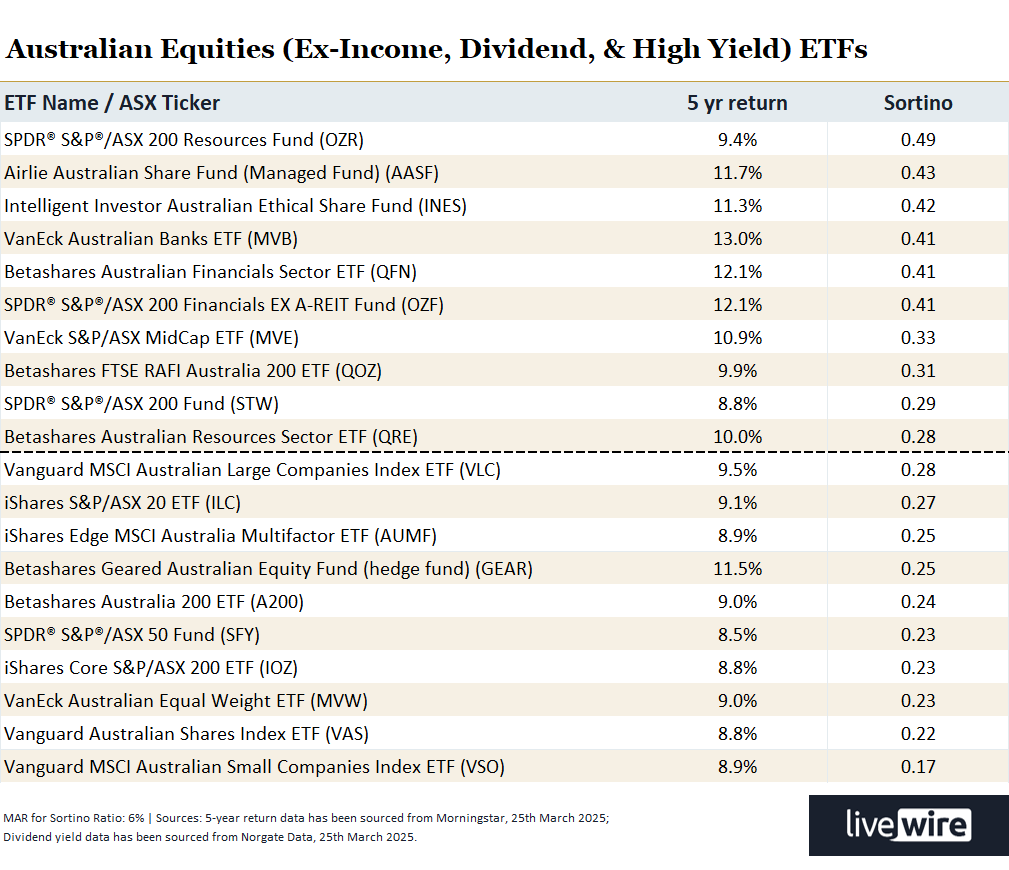%20ETFs.png)
The Top 10 Most Consistent Australian Equity ETFs (ex-Income, Dividend, & High Yield) over the last 5-years - the “Risk-Adjusted Return” list
I present the Top 10 Most Consistent Australian Equities Growth ETFs. The table above has sorted the top 20 candidates from the previous table by each ETF’s Sortino Ratio.
Note, I chose to use monthly returns in my Sortino Ratio calculations because we’re checking over a short lookback period of only 5-years of annual returns. I propose monthly volatility will provide extra sensitivity, plus an insight into the fluctuations felt by an investor who checked their portfolio at the end of each month.
It’s also important to note that the lookback period we’re using started with a >20% plunge in the S&P/ASX 200 in March 2020 – the beginning of the market’s reaction to the COVID-19 pandemic. Assuming you agree that something like this could happen again in the next 5-years – then you’ll probably also agree it’s valid to retain this performance in the sample.
The list is headed up by the SPDR® S&P®/ASX 200 Resources Fund (ASX: OZR). This surprised me – eleventh in the return-only list to first in the risk-adjusted return list is no mean feat. But, I think much of the reason for this leap lies in how well OZR performed in that fateful month of March 2020. The OZR lost the least of its peers in the above list – just 13.5% versus an average loss of 22.5% among the other 19 funds.
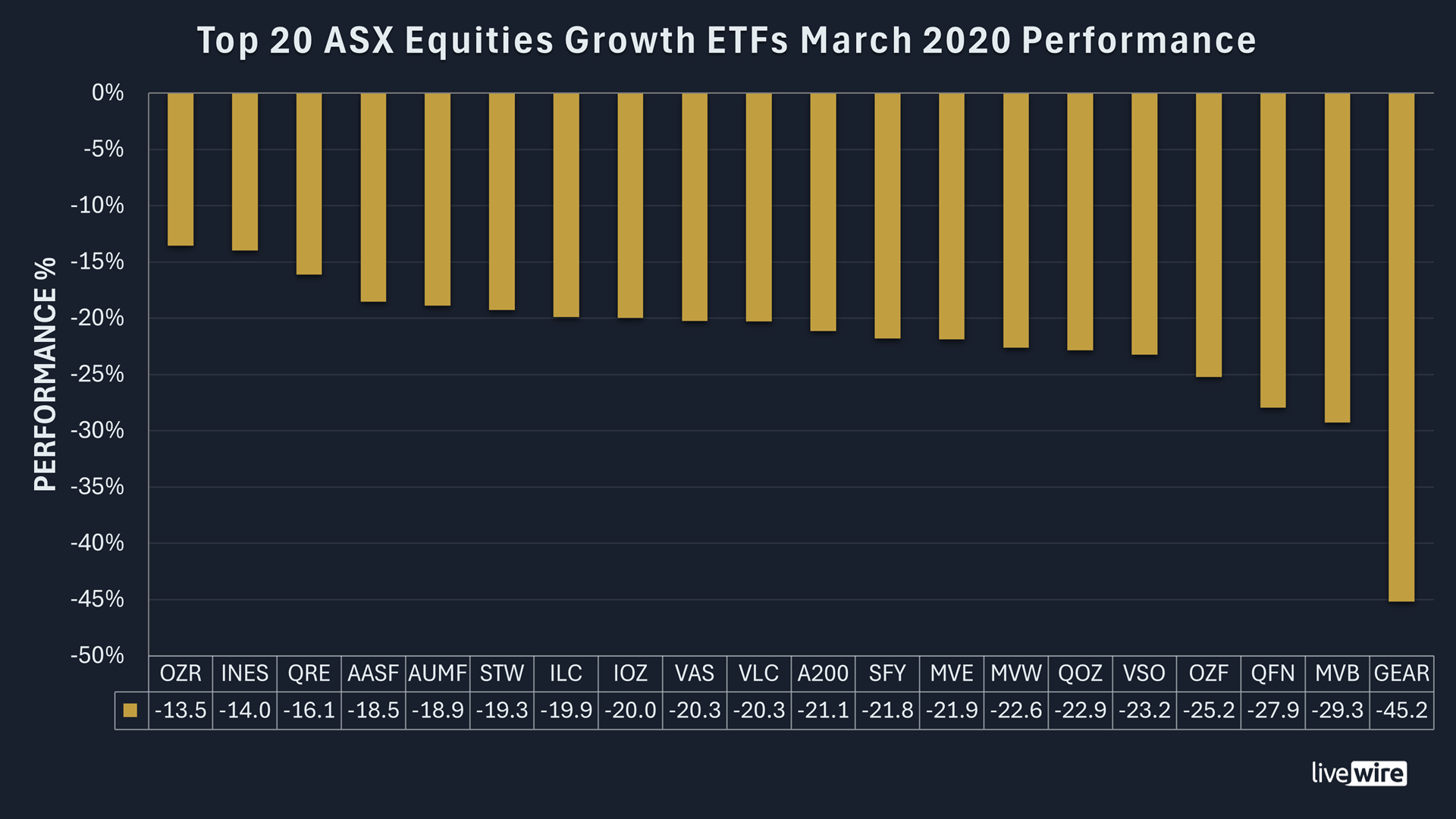
Top 20 Australian Equities Growth ETFs – March 2020 Performance (Source: Norgate Data)
The Sortino Ratio is designed to punish downside risk, and therefore to reward a lack of it. I suspect OZR’s superior March 2020 performance skewed the study results substantially in its favour. I could remove March 2020 from the sample and see how the tables reshuffle – consider Betashares Geared Australian Equity Fund (ASX: GEAR) lost a whopping 45.2% in March 2020 reflecting its geared nature – but again…could a drop like that happen again?
Perhaps the omission of March 2020 is the topic for another article, and let me know in the comments below if you’d like me to do the research. But for now, I suggest March 2020 stays!
Whilst OZR’s 9.5% p.a. compound annual return over the 5-year period put it fourth on the return only list, its relatively lower volatility than its peers over the period meant it had the highest Sortino Ratio, and therefore it topped the risk-adjusted return list.
In second was Airlie Australian Share Fund (Managed Fund) (ASX: AASF). It moved up two spots from fourth in the return only list. Again, as can be seen from the chart above, AASF was another comparatively strong performer during March 2020’s chaos, as was third placed Intelligent Investor Australian Ethical Share Fund (ASX: INES).
MVB (VanEck Australian Banks ETF) deserves a special mention for a couple of reasons. Firstly, it moved from top of the return only list to fourth in the risk-adjusted list – I suggest still a commendable performance – but it was also the second worst performer in March 2020. This suggests MVB likely delivered substantially lower downside volatility during the rest of the lookback period. Save for that March 2020 performance, MVB very likely would have featured much higher in the risk-adjusted return stakes.
The other ETF that dipped down the risk-adjusted list was Betashares Geared Australian Equity Fund (hedge fund) (ASX: GEAR) – from fifth to fourteenth versus the return only list. Long-only geared investments tend to do well in times of low volatility uptrends, but are likely to suffer during periods of higher volatility and downtrends. It certainly got clipped in March 2020!
Top 10 Global Equities & Thematic (Ex-Income, Dividend, & High Yield) ETFs
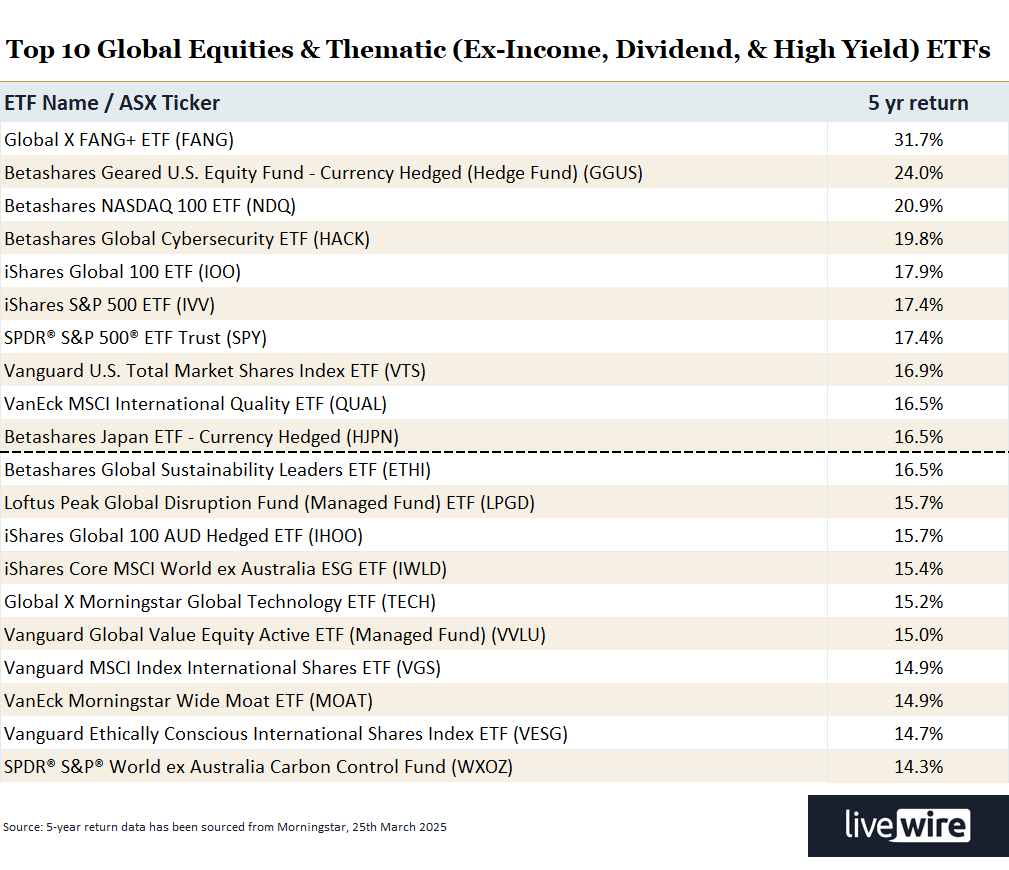%20ETFs.png)
Now that we understand the basis of comparison of our most consistent ETFs lists, the rest of these categories should be a breeze. The table above shows the 20 best performing global equities and thematic ETFs over the last five years, the second installment of our growth options.
The first thing you’ll notice is the performances here are far superior to those delivered by the Australian equities growth top 20 – nearly double in some cases and nearly triple for table topper Global X FANG+ ETF (ASX: FANG).
FANG+ implies the fund is invested in US technology stocks-royalty like Facebook (now Meta Platforms), Apple, Amazon, Netflix, and Alphabet (Google). Checking the fund’s website, it notes holdings also include the likes of Microsoft, NVIDIA, and Broadcom among other well-known US technology companies.
We know these stocks have had a “Magnificent” 5-years to say the least, and therefore FANG’s 31.7% p.a. compound annual return – an absolute monster by any standard – is probably little surprise to many. But it’s likely those high-flying US tech-megacaps also had a substantial influence on the performances of most of the remainder of the top 20.
One final observation. The best performing Australian equities growth ETF, MVB with its 13% p.a. compound annual return, wouldn’t have even made last place in the above list – not even our incredible banks could have cracked this US tech-dominated leaderboard!
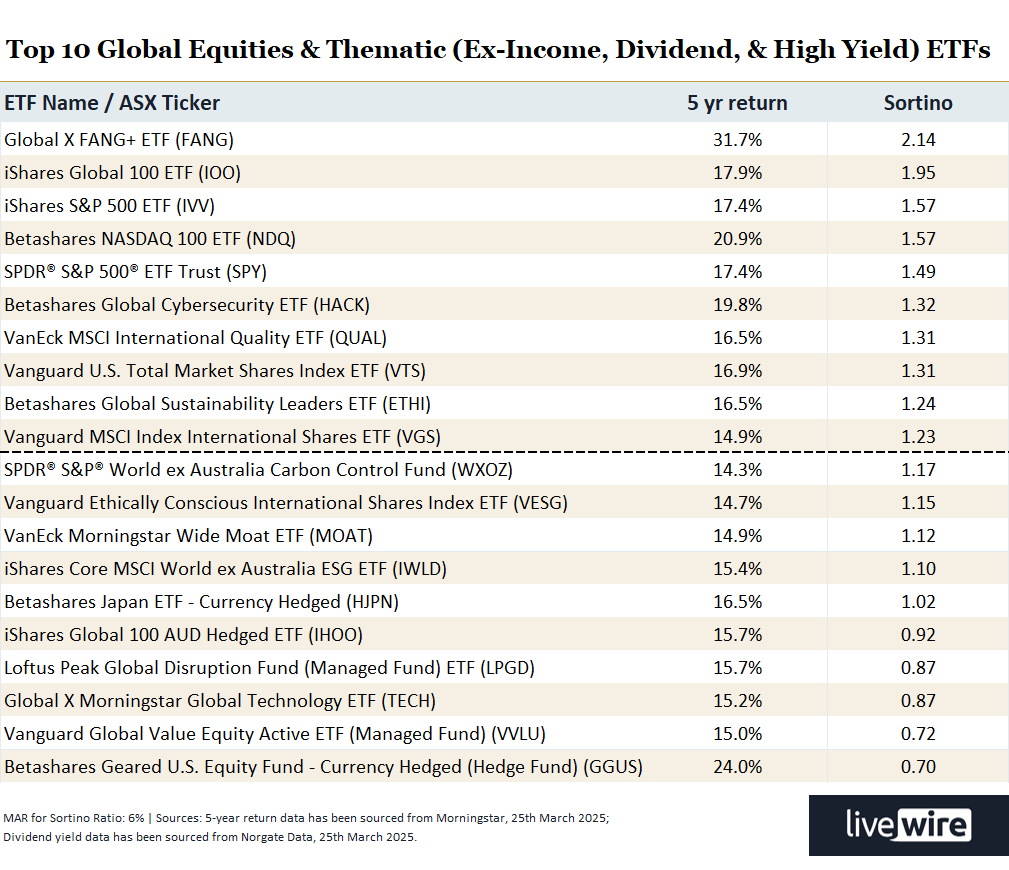%20ETFs.png)
Now that you’re a connoisseur of risk-adjusted returns, no doubt you’ve also noticed from the above table that the superior returns from global equities growth options weren’t achieved with substantially higher risk. I present the Top 10 Most Consistent Global Equities & Thematic Growth ETFs.
Every one of the top 20 delivered more return per unit of risk than their Australian counterparts – and substantially so when we consider FANG’s 2.14 Sortino Ratio is more than four times better than OZR’s barely “acceptable” 0.49.
The analysis I’ve done here suggests the risk-adjusted performance of Australian shares over the last 5-years was mediocre – both on a relative basis to the global options listed above, and compared to the aforementioned Sortino Ratio rules of thumb.
This highlights perhaps the main benefit of ETFs: The ability they afford regular Australian investors to diversify their portfolios from the customary big-four banks and three resource companies that most inevitably hold. Each of the above ETFs were there 5-years ago, sitting on your broking platform, just a few keystrokes away from (tap) B (tap) H (tap) P (enter)!
THE MOST CONSISTENT ASX INCOME ETFs
Top 10 Australian & Global Income, Dividend, & High Yield ETFs
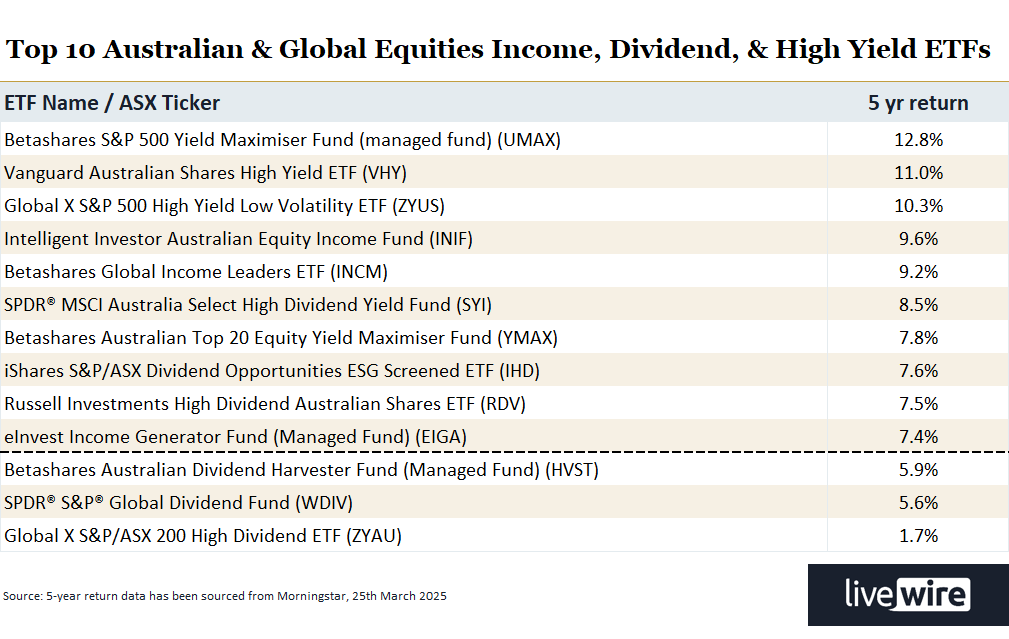
Top 10 Australian & Global Income, Dividend, & High Yield ETFs over the last 5-years – the “Return Only” list
Now we pivot to the top 20 performing Australian and global equities income ETFs over the last 5-years. These are the ETFs that state in their overviews a focus on income and/or dividends and/or high yield. Note, I have combined Australian and Global funds as there were only 13 of them in total.
Australian equities-based income funds delivered roughly similar performances to their growth counterparts, with Vanguard Australian Shares High Yield ETF (ASX: VHY) topping the list with 11.0% p.a. compound annual return over the last 5-years. As for the global equities income funds, these appeared to deliver far inferior returns to their growth counterparts, with BetaShares S&P 500 Yield Maximiser Fund (ASX: UMAX) topping the global options with a 12.8% compound annual return over the last 5-years.
Neither result is particularly surprising. For ASX funds, many of our so-called income stocks like the big banks and big resources companies have massive market weightings. This means there’s likely to be very little difference between the performances of growth and income ETFs focussed on ASX-listed alternatives.
Similarly, it’s also not surprising that for the global variants, there was such a stark difference between the performances of growth and income ETFs. This is because the major US tech stocks that so-often dominate growth ETF holdings are typically not big dividend payers – meaning it’s more likely global growth and income ETFs hold very different portfolios.
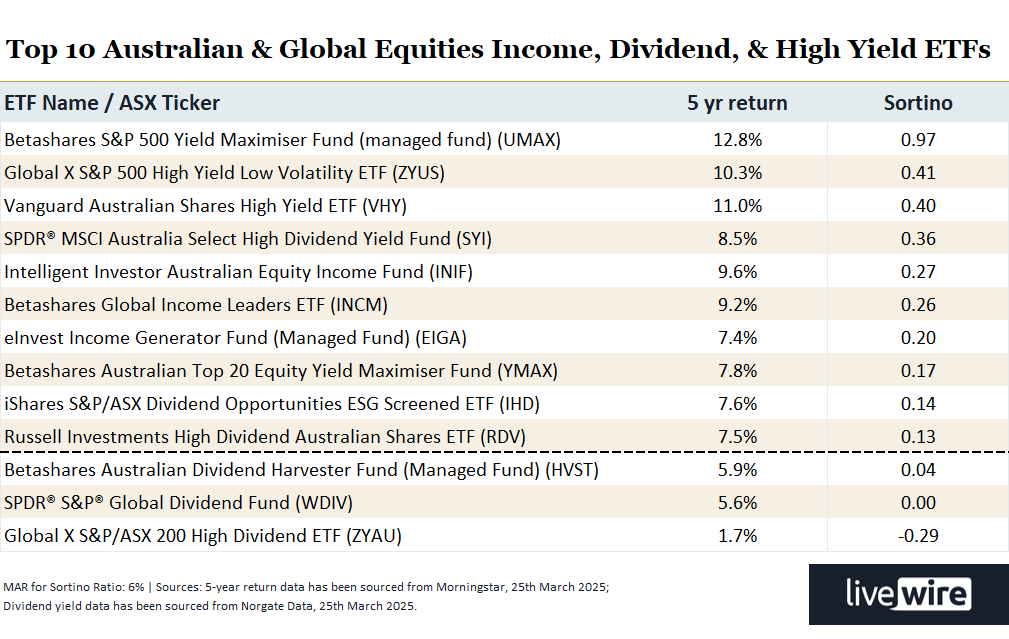
Top 10 Australian & Global Income, Dividend, & High Yield ETFs over the last 5-years – the “Risk-Adjusted Return” list
I present the Top 10 Most Consistent Australian & Global Equities Income ETFs. Only a modest shuffling of the deck for this cohort after adjusting for risk. UMAX retains top spot with a highly commendable 0.97 Sortino Ratio. It’s an income ETF that has delivered a comparable return to the best Australian equities growth ETFs (MVB–13.0% p.a.) but with substantially better risk-adjusted return.
But, and I’m sure all you dividend aficionados out there have already objected – the mix of capital gains and dividends an investment provides is vitally important to many. The returns shown here are total returns, they include both capital gains and dividends. Some investors prefer a greater proportion of dividends to capital appreciation as they rely on regular dividend payments to fund their living expenses.
Understanding the mix of capital gains to dividends each ETF provides is beyond the scope of this article, and I will leave it to your own research to investigate the ETFs presented here. But for those who don’t care how their return is earned, and just want the best risk-adjusted returns for their portfolios, you can just read off my tables as they are.
One important thought I will leave you with before we depart for the final segment of my research is this: Looking at the Sortino Ratios of most Australian equities income funds, their risk-adjusted returns are generally inferior to their growth counterparts. It appears one is not being compensated for lower returns in these ETFs with commensurately lower risk – even if the words “income”, “dividend”, or “high yield” are on the label!
Top 10 Cash & Fixed Interest ETFs
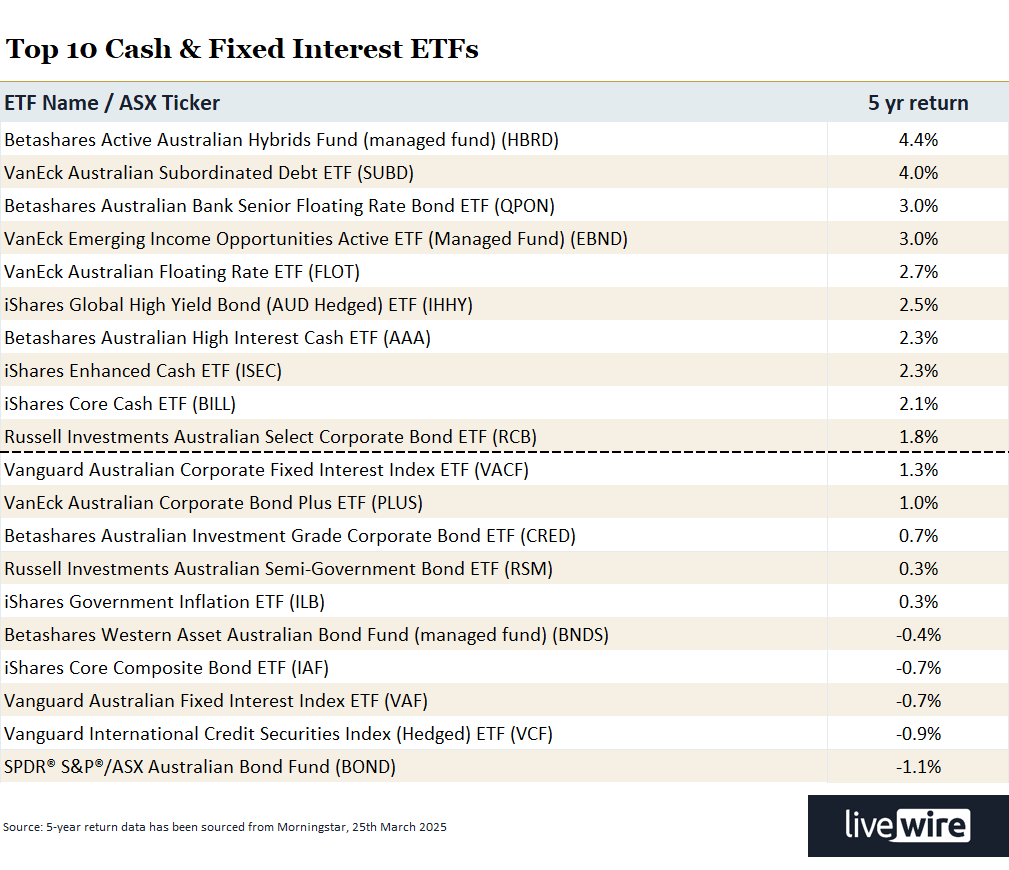
Top 10 Cash & Fixed Interest ETFs over the last 5-years – the “Return Only” list
Let’s conclude with the group of ETFs that are as income as you can get – non-equities based ETFs that invest in cash or fixed interest securities like notes and bonds. The discussion of how these assets operate is beyond the scope of this article, but in a nutshell, the goal is typically to earn a periodic interest-based return and to recoup 100% of one’s capital at the conclusion of the investment.
Cash is in theory the ultimate risk-free asset as we’d expect to recoup our initial investment 100% of the time. In theory, this should also be the case for fixed interest securities that are held to maturity, but there can be substantial differences in outcomes when fixed interest securities aren’t held to maturity. There’s also potentially default risk if the issuer of the security can’t make the required coupon / interest payments.
On that last item, I note counterparty risk can be largely eliminated by dealing only with the highest quality issuers – but the old adage “there’s no free lunch in the markets” applies: Higher quality issuers generally pay lower rates of interest on their fixed interest securities than lower quality issuers.
The main goal in investing in cash and fixed interest is regular and predictable income and capital preservation – and we want to be as close to certain on both. But, as we can clearly see from the above table that greater certainty (i.e., lower risk) equals lower return.
But remember! Investors in cash and fixed interest do not expect the 31.7% p.a. compound annual return of FANG, they just want a steady rate of return and to get their money back when they exit – so we shouldn’t consider these returns inferior to those shown in previous tables. It’s just a case of comparing apples and oranges.
Coming out on top in this category is Betashares Active Australian Hybrids Fund (ASX: HBRD). A “hybrid” security in this case refers to a fixed interest security that eventually converts to an equity security in the issuing company. Hybrids potentially have a greater risk profile because their value may fluctuate with the perceived creditworthiness of their issuer.
Interestingly, spots number two and three on the list are also largely focussed on fixed interest securities issued by companies. The VanEck Australian Subordinated Debt ETF (ASX: SUBD) and Betashares Australian Bank Senior Floating Rate Bond ETF (ASX: QPON) target bonds issued by banks, insurance, and other large finance companies, with the latter holding up to 80% of its assets in bonds issued by Big-4 ASX banks.
It’s not until spot four, VanEck Emerging Income Opportunities Active ETF (ASX: EBND) that we get the first government-only issued fixed interest ETF – albeit one with a substantial holding of emerging market government bonds (think Mexico, Columbia, Peru, etc.) and bonds issued by a few government-owned utilities.
If you only want to invest in the highest quality developed market bonds, there are few choices in the top 20, with iShares Government Inflation ETF (ASX: ILB) highest on the list.
There are, at least, a few more cash-only options to choose from in the top 20. Betashares Australian High Interest Cash ETF (ASX: AAA) came out best in category, followed closely by iShares Enhanced Cash ETF (ASX: ISEC).
Finally, let me address the elephant in the room. Many of the fixed interest-focussed ETFs delivered very low or negative returns over the past 5-years. Whilst this isn’t too common for fixed interest investments, it is possible – particularly if the lookback period encompasses rapidly rising official interest rates.
This certainly was the case for this study. At the start of the lookback period, markets experienced record low global official interest rates as central banks tried to protect the global economy from the COVID-19 pandemic. Then followed the similarly historic “lift-off”, where central banks were forced to rapidly increase their official interest rates to combat a post-pandemic spike in inflation.
This caused chaos in fixed interest markets as lower yielding securities were sold off in favour of higher yielding alternatives (as the price of a fixed interest security falls, its yield rises to better reflect market alternatives). It’s possible that some managers were caught by this move, choosing to trade out of lower yielding fixed interest securities rather than holding them to maturity.
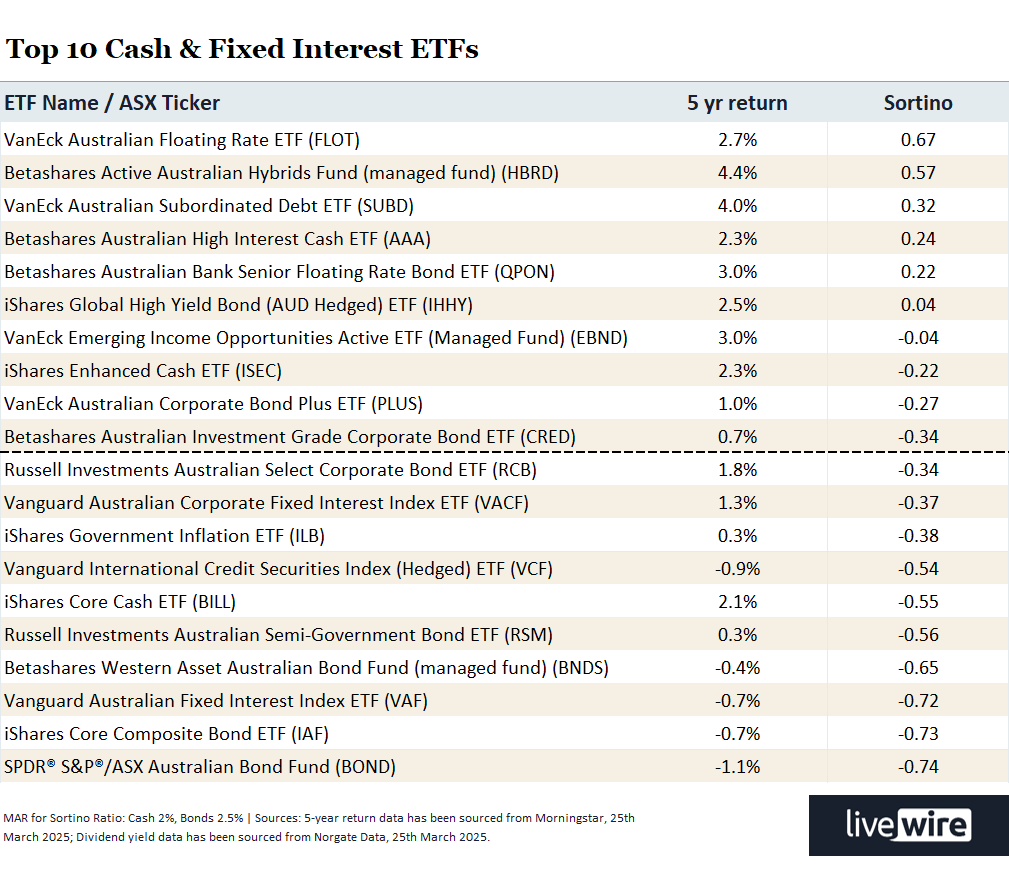
Top 10 Cash & Fixed Interest ETFs over the last 5-years – the “Risk-Adjusted Return” list
I present the list of Top 10 Most Consistent Cash and Fixed Interest ETFs. Note, I used an MAR of 2.0% for cash ETFs and 2.5% for fixed interest ETFs to reflect the lower hurdle rates respectively investors typically apply to these asset classes.
Given the wide variety of fixed interest securities held by the ETFs in this category, it feels much like trying to compare apples and oranges. But by using the Sortino Ratio, we can now get closer to comparing apples and apples!
The appropriately named VanEck Australian Floating Rate ETF (ASX: FLOT) has floated to the top of the risk-adjusted return list with a Sortino Ratio of 0.67. FLOT’s 2.7% p.a. compound annual return seems inferior to HBRD’s 4.4% and SUBD’s 4.0%, but not after considering how much downside risk was experienced in achieving each of those returns.
Thanks to the Sortino Ratio, we can also now compare these ETFs with ETFs across each of the other asset classes. I note that FLOT’s and HBRD’s Sortino Ratios are superior to all but one of the best ranked Australian Equities growth and income ETFs (UMAX–0.97 & OZR–0.49), and they would even rate highly against many of the other equities-based growth and income options.
And that’s kind of the whole point of looking at Sortino Ratios – it’s a great leveller – telling us how much return we would have earned for the downside risk experienced across any asset.
CONCLUSION
That last sentiment is the key takeaway here: The ability to compare the massive ASX ETF offering – now numbering over 350 – in a consistent way.
Yes, one shouldn’t compare FLOT’s Sortino Ratio of 0.67 with OZR’s 0.49 and automatically deduct FLOT is the better investment. FLOT returned 2.7% p.a. and OZR 13.0% p.a. compound annual return over the lookback period. If your goal is to earn at least 10% p.a. to retire comfortably in 20-years, then FLOT probably isn’t going to cut it. It can’t – because it’s simply not designed to deliver the return you require.
But we can deduce that FLOT did a better job in controlling its downside risk in achieving the return it did deliver than OZR did.
The goal of doing this analysis is to help you choose the best investment for the specific goal you’re trying to achieve with the specific capital you’ve allocated to a specific task – be it growth, income, capital preservation – or as we’ve seen with many ETFs a mix of these attributes.
Now you can compare returns within and across each asset class on a consistent risk-adjusted basis – like the professionals do – and make an educated choice as to which ETFs are likely to best help you achieve your investing goals.
Here are the best in class for each category – the Most Consistent ASX ETFs:
Most Consistent Australian Equities Growth ETF: SPDR® S&P®/ASX 200 Resources Fund (OZR) (5-year return 9.4% p.a. | Sortino Ratio 0.49)
Most Consistent Global Equities & Thematic Growth ETF: Global X FANG+ ETF (FANG) (5-year return 31.7% p.a. | Sortino Ratio 2.14)
Most Consistent Australian & Global Equities Income ETF: Betashares S&P 500 Yield Maximiser Fund (UMAX) (5-year return 12.8% p.a. | Sortino Ratio 0.97)
Most Consistent Cash & Fixed Interest ETF: VanEck Australian Floating Rate ETF (FLOT) (5-year return 2.7% p.a. | Sortino Ratio 0.67)
5 topics
23 stocks mentioned
18 funds mentioned


